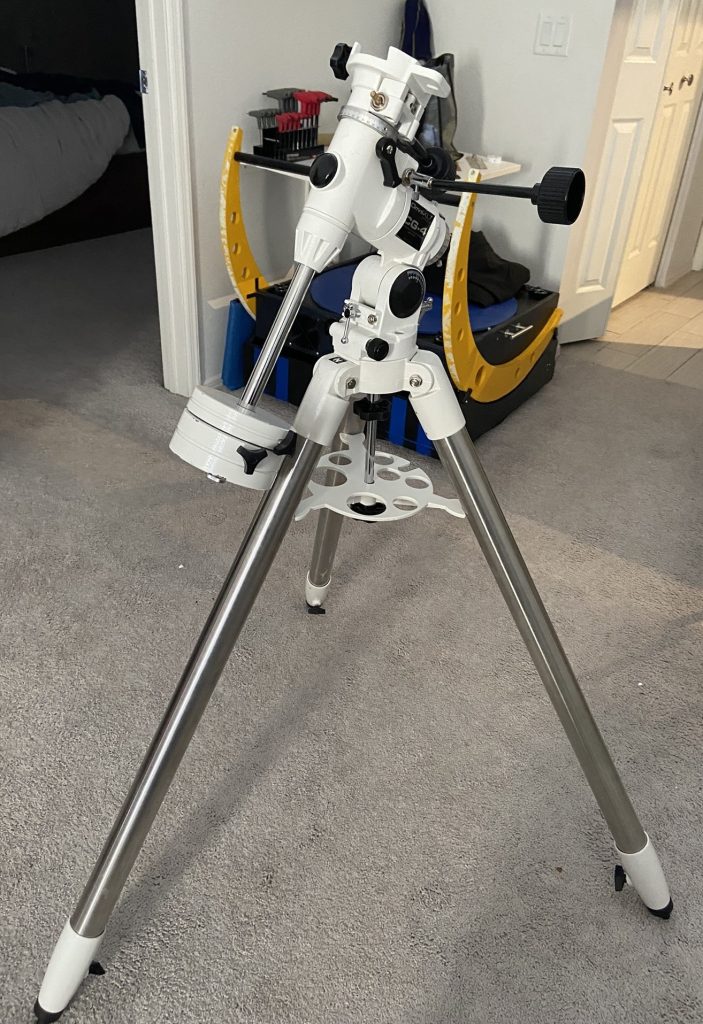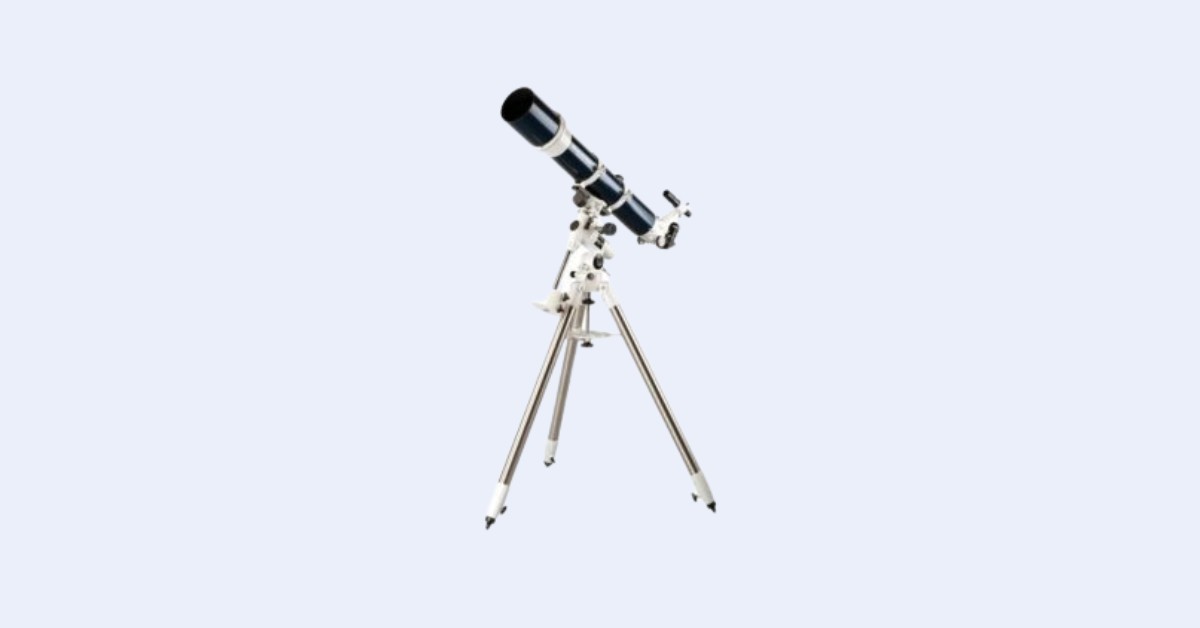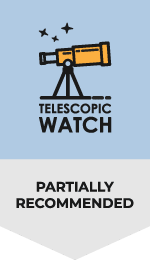Omni XLT 120 OTA Performance
The Omni XLT 120 is a 120mm (4.7”) aperture refractor telescope with a focal ratio of f/8.3. At this aperture and focal ratio, I do notice a somewhat-significant amount of chromatic aberration as expected, but the lunar and planetary views are still excellent. I could see color fringes on anything brighter than 3rd magnitude, but high-power views are no problem, and images don’t “break down” the way they do with faster or cheaper achromat refractors.
I find the optical quality to be top-notch, especially considering it’s an inexpensive achromat. The lens cell is also collimatable should the need arise. I also like that there is zero plastic anywhere in the scope.
The Omni 120 has a 2” all-metal, single-speed rack-and-pinion focuser. Even though it works well enough, it can be hard to get the focus right at high magnifications and can slip when carrying heavy loads. I would recommend replacing it with a GSO Crayford focuser or even a Moonlite or Feathertouch focuser.
The Omni 120 attaches to its CG-4 mount using a pair of hinged tube rings and a Vixen dovetail bar. I can piggyback a DSLR or point-and-shoot camera using the included ¼ 20 captive screw/knob on one of the rings and shoot wide-field astrophotos if I equip the CG-4 mount with a motor drive.
My Experience With the Accessories
The Omni XLT scopes are all fairly Spartan when it comes to the included accessories: simply a 25mm Plossl and a 6×30 finder, as well as a 1.25” prism star diagonal.
The 25mm Plossl eyepiece has a special long-eye relief design and worked pretty well for low power, while the 6×30 finderscope was uncomfortable to use and provided rather dim images. The included star diagonal is really nice and is all you need if you want to stick with 1.25” eyepieces.
The Omni XLT 120 only comes with one eyepiece, and it’s safe to say it’ll benefit from additional ones. What exactly you purchase is up to you, but I’d recommend at least a 6mm goldline (167x) to start for high-magnification lunar, planetary, and double star viewing.
Along with good eyepieces like the Explore Scientific 68- or 82-degree, or the Baader Hyperion series, a 2″ star diagonal might also be useful for making low-power views wider.
About the Omni CG-4 Mount

The Omni CG-4 is a professional-grade mount based on the Celestron’s own Advanced VX mount. It should not be confused with the older, black CG-4, which has legs made of extruded aluminum and cheap plastic parts.
I see it as more or less an Advanced VX stripped of electronics and with thinner tripod legs (1.75” vs. 2”). Since the electronics are the main thing people complain about with the VX, what I’m left with is a high-quality, all-metal mount capable of carrying up to 20 pounds of payload. I trust my premium Takahashi FC-76 refractor on this mount, and it is really one of the best bargains you can get on a manual mount these days.
You can upgrade the CG-4 with single-axis or dual-axis motors for hands-free tracking and slewing, as well as a polar scope for precise polar alignment. There are even kits out there to add GoTo and autoguiding capability to the CG-4 so you can use it with a small apochromatic refractor for astrophotography if you desire.
In my view, the CG-4’s only flaw is the short tripod legs. With a much shorter refractor (such as my FC-76), the eyepiece is a little low even with the tripod legs extended all the way, and with the Omni 120, it’s near the ground. You can, however, buy or make a mount pier extension, which will make you much more comfortable at the cost of a little more weight and, of course, less portability and ease of use.
Should I buy a used Omni XLT 120?
Absolutely! There’s not much to go wrong with a used, all-manual refractor—just make sure the objective lens is in good shape and that the mount moves smoothly.
Alternative Recommendations
The Celestron Omni XLT 120 is certainly a nice telescope, especially for a fairly inexpensive refractor so large.
But beginners might want something with more aperture and free of chromatic aberration, while those looking for a “grab n’ go” telescope will probably desire a smaller telescope with a less bulky mount or awkwardly long tube.
- The Apertura AD8 offers just under triple the light gathering power of the Omni XLT 120 and nearly double the resolving power, free of the troublesome chromatic aberration that plagues cheaper achromatic refractors like the XLT 120. The magnitude-brighter views are a huge help with viewing deep-sky objects. The AD8 also includes a 2” dual-speed Crayford focuser, built-in cooling fans, and a variety of high-quality accessories like a 9×50 right-angle correct-image finder scope, 2” 30mm wide-angle SuperView eyepiece, and of course a stable, lightweight, and easy-to-use Dobsonian mount that doesn’t require polar alignment, adjusting slow-motion knobs, or locking any clutches to aim around the sky.
- The Explore Scientific 10” Hybrid Dobsonian offers more than double the resolving power and 4.5 times the light-collecting area of the Omni XLT 120, providing far brighter and sharper images than the Omni XLT 120 can possibly achieve. The collapsible truss tube allows the scope to fit in a fairly small space but still assembles in minutes with no tools, and the scope’s mount is buttery smooth and easy to aim around the sky. There’s only a single-speed 2” Crayford focuser and only a basic (and low-quality) red dot finder and low-power 1.25” eyepiece are included – but the same is true of the Omni XLT 120 and many other otherwise high quality scopes anyway.
- The Sky-Watcher Virtuoso GTi 150P offers a slight uptick in light gathering and resolving power compared to the Omni XLT 120, with the perks of a much wider field of view and freedom from the annoying chromatic aberration thanks to its Newtonian optical design. The Virtuoso GTi 150P’s collapsible tube and tabletop Dobsonian mount make it lightweight and portable, and the mount features fully computerized tracking and GoTo capabilities that can be ready in minutes and is controlled entirely via your smartphone or tablet.
- The Celestron Astro-Fi 130 has essentially the same light-gathering and resolving power as the Omni XLT 120, but of course lacks chromatic aberration since it is a reflector, and the shorter focal length allows for a wider possible field of view. This telescope comes with a pair of decent eyepieces and its mount features fully motorized tracking and GoTo, all controlled with the SkyPortal or SkySafari app on your smartphone or tablet. However, the Astro-Fi cannot be aimed manually and is kind of expensive considering the fairly small aperture and relative lack of features/accessories, particularly when compared to the Virtuoso GTi tabletop Dobsonian telescope offerings from Sky-Watcher.
What can you see with the Celestron Omni XLT 120?
The Omni XLT 120 is primarily a lunar and planetary instrument, but its aperture is big enough to show you a fair number of deep-sky objects too.
- Within the Solar System, the Omni XLT 120 is capable of showing us a wealth of detail on the Moon, along with, of course, the phases of Mercury and Venus.
- Mars’ polar ice caps and a few dark areas are visible when the planet is close to Earth, which occurs for a few months out of every two years.
- Jupiter’s cloud belts, the Great Red Spot, and various fainter festoons and swirls are visible in its turbulent atmosphere, and the 4 Galilean moons circling the planet are visible as tiny disks when they eclipse and transit Jupiter every so often.
- Saturn’s rings, the division in them, and several moons can be spotted, along with some low-contrast cloud belts.
- Uranus and Neptune are merely bluish dots, devoid of atmospheric features or visible moons.
When it comes to deep sky observation, the better the skies you have and the more skilled you are at observing, the better your chances are.
- The 120mm aperture is just barely enough to start resolving globular clusters’ individual stars, such as those in M13, M15, M92, M22, M2, or M3.
- There are a lot of planetary nebulae that can be seen, like M27, M57, the Cat’s Eye, and the Blinking Planetary.
- Open clusters look great and benefit from the wide fields that can be provided with the modest focal length of the Omni 120.
- You’ll also be able to see most of the Messier galaxies and many of the brighter NGC objects, some of which will show details like dust lanes or spiral arms under dark skies.
- Bright emission nebulae like M42, the Orion Nebula, and M8, the Lagoon Nebula, look great even under light-polluted skies, filled with stars and faint wisps of gas.
Astrophotography Capabilities of the Scope
While the chromatic aberration of the Omni 120 for visual observation isn’t severe, it would certainly be a nuisance for imaging, particularly deep-sky astrophotography.
Additionally, even with dual-axis drives and autoguiding, the CG-4 cannot track accurately enough for deep-sky astrophotography with the Omni 120 optical tube. This is mostly due to the strain placed on it by the high weight (12.5 pounds for the OTA plus at least 5 for the camera/guide scope, and the mount only has 20 pounds of capacity). Thus, the Omni XLT 120 is really not an astrophotography telescope.




I have the 120xlt. Not possible to view objects overhead because it’s impossible to look through the finderscope. I attached a green laser pointer. I just put the laser on the high overhead object I want to view and it’s in the eyepiece! Great quality telescope. Cuts through heavy light pollution. Grrat purchase.